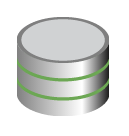To understand how clinical decision support (CDS) works, it is important to understand how CDS fits within the logical architecture of an EHR system. This section describes the major architectural components of an EHR system, and the interactions between these components.
Major Components
Table 2.1-1: Descriptions of the major architectural components of an EHR system
EHR System Component | Description | |
User Interface | The user interface (UI) is a fundamental component of almost any clinical application, and is used within an EHR to both enter and display patient health records. The UI also has two main CDS functions. Firstly, the UI is used to provide inputs to the CDSS, such as recording a proposed medication or an observed finding. The second function of the UI is to display alerts, advisories and clinical guidelines to the user in an appropriate format, on behalf of the CDSS. | |
Record Services | Record services are a set of services for managing patient health records. Record services provide functions like entering data into health records, searching for and retrieving health records, querying or extracting data from health records, and communicating or exchanging health records with other systems or applications. Record services interact with other components in this model such as the CDSS and the UI. | |
Terminology Services | Terminology services are those services that directly manage the terminology resources. They include functions like querying concepts, relationships and reference sets, and installing or updating SNOMED CT from release files. Terminology services interact with the CDSS component in this model. | |
Clinical Decision Support System | The primary role of the CDSS is to execute the decision support logic. The CDSS does this using a number of subcomponents and subprocesses, which will be described in the next section - Logical Architecture of a CDSS. The CDSS interacts with each of the other major components in the EHR. | |
Interactions
The major architectural components of an EHR system that incorporates CDS interact with each other in a variety of ways to support the overall functioning of the EHR. The diagram below uses orange arrows to illustrate the primary interactions between these EHR components.
Figure 2.1-1: EHR components and key interactions
As shown above, the UI communicates with the record services to facilitate the storage and subsequent retrieval of health record data. The UI also provides inputs to the CDSS and displays alerts and guidelines on its behalf. The CDSS uses the inputs from the UI and data from the record and terminology services to processes decision support rules. The CDSS uses the inputs from the record and terminology services to determine whether or not the CDS conditions have been met, and if so then CDS interventions, such as alerts or knowledge resources, are delivered back to the UI. The internal components and processes of the CDSS will be described in more detail in the next section - Logical Architecture of a CDSS.Feedback




